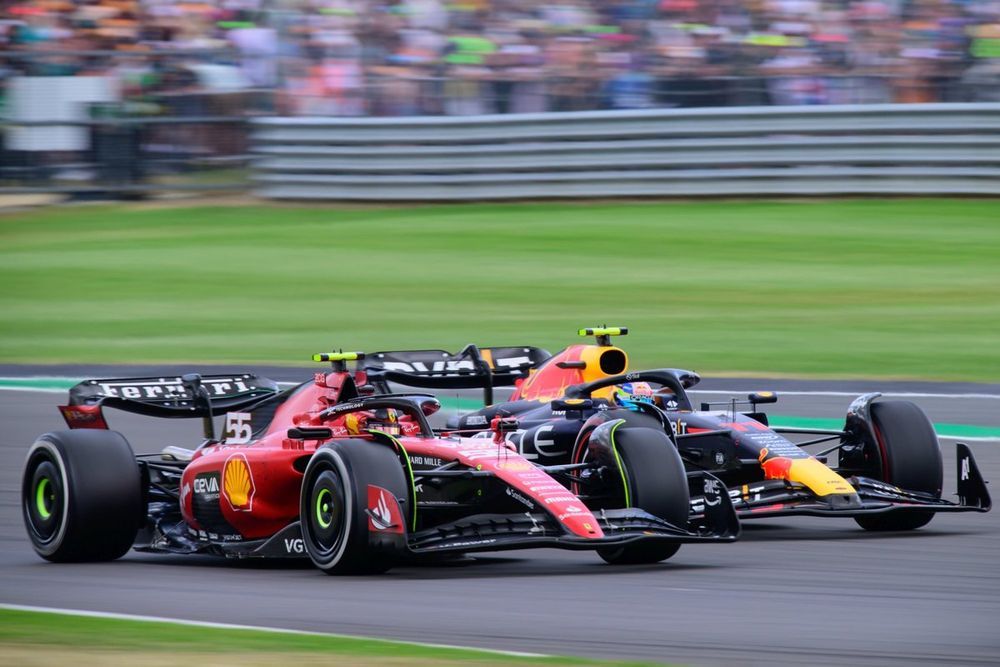
Far behind sovereign Red Bull, which has won all 10 grands prix so far, Mercedes holds second as F1 heads towards the halfway point the season.
But it has been a bumpy road to get there, with the status of second-fastest team changing hands on a week-to-week basis.
Surprisingly, Aston Martin started the season in that position, but it has been sliding back in recent weeks on high downforce tracks. Mercedes has been there or thereabouts but has suffered some off-kilter weekends too, even after its radical Monaco upgrades.
Then there's Ferrari, which has often struggled with consistency between tyre stints, never mind between races. The Scuderia appeared to have turned a corner in Austria, before enduring a disappointing weekend in Silverstone, where McLaren suddenly emerged as a contender thanks to a mid-season car overhaul.
The margins are so fine that adding any upgrades to the car can make an immediate, significant impact to the pecking order behind Red Bull. But according to Ferrari team principal Fred Vasseur, F1 2023's confusing form table is not just about the development war as more time can be gained by nailing the set-up and tweaking the car to a particular circuit type.
"I'm not sure that it's development, it's also set-up during the weekend, because the development at one stage you will have a kind of an asymptote [a curve which gradually flattens out]," Vasseur replied when asked by Motorsport.com if 2023 is all about which team develops the quickest.
"With upgrades you will make one or two tenths. With set-up and the preparation of the weekend, you can do more than this.
"You can't bring an upgrade on the car every single week. We'll have parts soon, but if I have a look at the [British Grand Prix] weekend, I think we could have had a much better usage of the car that we had."

According to Tom McCullough, Aston Martin's performance director, changing circuit characteristics also play a role in the fluctuating gaps. With this generation of ground-effect cars, teams are forced to find a ride height compromise between low and high-speed corners, which is seen as one of the keys to being competitive.
"I think we've got a good understanding of our own car and what the strengths are of that car," He said. "We understand the traps, in qualifying so much of the lap is flat out, so therefore your drag and rear wing level is really important.
"And then you got a lot of high-speed and low-speed corners. And there wasn't really a big differentiator in high-speed performance between the teams.
"Obviously, the low-speed performance is still very key around [Silverstone]. And that was maybe the differentiator between a lot of the teams but we're learning, people keep updating the cars, so every race you analyse and try to understand their strengths and weaknesses."
His Williams counterpart Dave Robson, whose team started making massive progress in recent races with an eighth place for Alex Albon in Silverstone, is at a loss to explain some of the recent performance swings, including McLaren's resurgence.
Building a pecking order is further complicated by external circumstances. The past three grand prix weekends have all been hit by rain, which disturbed the teams' preparation, while Austria was a sprint weekend with limited practice and Pirelli brought a new, tougher tyre construction to Silverstone that teams needed to get on top of.
A new tyre format experiment follows in Hungary, before the third sprint of the season in Belgium closes a particularly challenging first half of the 2023 season.

When asked by Motorsport.com if the teams' relative performance differences have become confusing, Robson replied: "They seem to be but it's not really clear why that should be."
"The McLaren is a great example. Those Q3 laps were outstanding. And if they can understand why that was the case, and why they weren't showing that earlier on, then fair play to them. There does seem to be just a bit more variance that I think everyone struggles to explain.
"The weather we've had recently at events also makes it really difficult to get the data you need, and it adds much more noise to try to assess where you are relative to the others."
While teams generally set their own development pace regardless of the competition, Robson explained that the tight confines of the midfield have added a strategic element to the timing of introducing new packages, as they could make the difference between Q2 and Q3.
"This offsetting of the upgrades is quite fascinating and makes it quite difficult to know in advance how to pace your introduction of the upgrades because really, you want to do it at the most strategic time relative to what everyone else is doing," he added.
"Our Canada package is working well. There are a lot of upgrades [in Silverstone] but I suspect teams, because of the weather, haven't had a chance to get the most out of them or understand them.
"They'll have to pick that up in Hungary, then we've got the tyre format in Hungary. And then we're into a sprint event at Spa. So, it is difficult, but it is a fascinating challenge and fascinating to see how different teams react."







